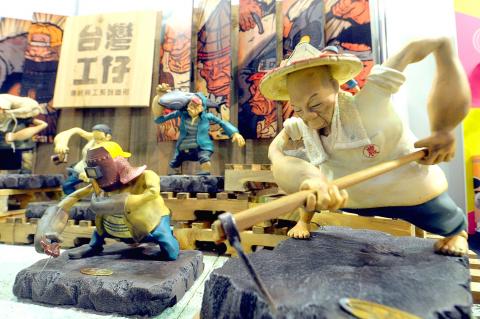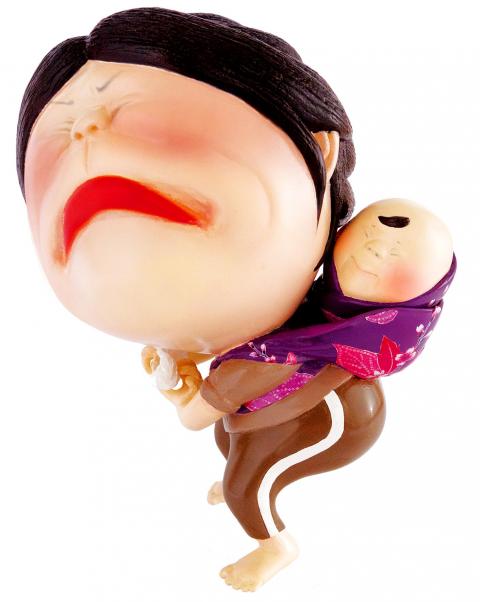Grown-ups who are kids at heart (and real kids with some extra spending money) will have plenty to do at the eighth annual Taipei Toy Festival (台北國際玩具創作大展), which runs through Sunday at Huashan 1914 Creative Park (華山1914).
The event is the largest convention in Asia dedicated exclusively to art toys (commonly referred to as urban vinyl) and character design. Launched in 2004, the event is organized by designer toy importer Monster Taipei (台北怪獸). This year’s edition will feature more than 80 booths and over 200 individual designers, ranging from the team behind well-known brands like kennyswork and Winson Creation to up-and-coming artists.
Monster Taipei says it expects a total of 38,000 visitors over the course of the event. The first 500 visitors each day will receive a limited edition figure and are eligible to enter drawings for prizes like a round-trip plane ticket to Hong Kong (where designer toys first gained popularity during the mid-1990s), Hong Kong Disney tickets, an Asmus Toy 12-inch figure and WaveMonkey hats, belts and limited edition CDs.

Photo: Wang Min-wei, Taipei Times
The festival is known to collectors for its selection of hard-to-find limited edition figures. Highlights this year include the surreal Three-Eyed Mickey, a collaboration between Clot Inc (Edison Chen’s (陳冠希) T-shirt company), Los Angeles-based MINDstyle and Disney.
The year’s event will shine a spotlight on Old Master Q (老夫子), the classic comic book character that has entertained readers in Chinese-speaking countries for nearly half a century. Joseph Wong (王澤), the son of Old Master Q creator Alfonso Wong (王家禧) and the series’ current author, collaborated with toy designers for a special exhibition focused on the series. It will include original manuscripts and one-off handmade figures.
Today’s events include autograph signing sessions with Taiwanese designers Kasing Lung (龍家昇) and Captain Butter (奶油隊長) and American artist Amanda Visell. Fans can line up tomorrow to meet the designers of Japanese brand Dankeschoen, Old Master Q’s Joseph Wong, Hong Kong designer Kenny Wong (王信明) of Kennyswork, Spencer Ong of Rotobox and David Quiles of Outta My Mind Creations. The event closes on Sunday with a signing session by the artists of Taiwan Comix 3, an anthology, and a “live painting” session with the artists behind Devilrobots.

Photo courtesy of Monster Taipei

Following the shock complete failure of all the recall votes against Chinese Nationalist Party (KMT) lawmakers on July 26, pan-blue supporters and the Chinese Communist Party (CCP) were giddy with victory. A notable exception was KMT Chairman Eric Chu (朱立倫), who knew better. At a press conference on July 29, he bowed deeply in gratitude to the voters and said the recalls were “not about which party won or lost, but were a great victory for the Taiwanese voters.” The entire recall process was a disaster for both the KMT and the Democratic Progressive Party (DPP). The only bright spot for

As last month dawned, the Democratic Progressive Party (DPP) was in a good position. The recall campaigns had strong momentum, polling showed many Chinese Nationalist Party (KMT) lawmakers at risk of recall and even the KMT was bracing for losing seats while facing a tsunami of voter fraud investigations. Polling pointed to some of the recalls being a lock for victory. Though in most districts the majority was against recalling their lawmaker, among voters “definitely” planning to vote, there were double-digit margins in favor of recall in at least five districts, with three districts near or above 20 percent in

From Godzilla’s fiery atomic breath to post-apocalyptic anime and harrowing depictions of radiation sickness, the influence of the nuclear bombings of Hiroshima and Nagasaki runs deep in Japanese popular culture. In the 80 years since the World War II attacks, stories of destruction and mutation have been fused with fears around natural disasters and, more recently, the Fukushima crisis. Classic manga and anime series Astro Boy is called “Mighty Atom” in Japanese, while city-leveling explosions loom large in other titles such as Akira, Neon Genesis Evangelion and Attack on Titan. “Living through tremendous pain” and overcoming trauma is a recurrent theme in Japan’s

The great number of islands that make up the Penghu archipelago make it a fascinating place to come back and explore again and again. On your next trip to Penghu, why not get off the beaten path and explore a lesser-traveled outlying island? Jibei Island (吉貝嶼) in Baisha Township (白沙鄉) is a popular destination for its long white sand beach and water activities. However, three other permanently inhabited islands in the township put a unique spin on the traditional Penghu charm, making them great destinations for the curious tourist: Yuanbeiyu (員貝嶼), Niaoyu (鳥嶼) and Dacangyu (大倉嶼). YUANBEIYU Citou Wharf (岐頭碼頭) connects the mainland